An Improved Version of ETS-Regression Models in Calculating the Fixed Offshore Platform Responses
Abstract
:1. Introduction
2. Platform Specifications and Wave Modelling Analysis
2.1. Test Structure Specifications and Offshore Platform Models
2.2. Numerical Simulation of Offshore Structural Responses
2.3. Evaluation of Short-Term Probability Distribution of Extreme Offshore Structural Responses Using MCTS Method
3. Development of Improved ETS-Regression Procedures
3.1. Relationships of ETS-RSE and ETS-RLR
3.2. Regression Models of ETS-RegSE and ETS-RegLR
4. Derivation of Short-Term Probability Distribution of Extreme Offshore Structural Responses
4.1. Preliminary Analysis of Extreme Responses by Three Types of ETS-Reg Models
4.2. Level of Accuracy of Extreme Responses by ETS-Reg Models
5. Conclusions
- In the current study, the comparison of the probability distribution of quasi-static extreme responses values was validated between the MCTS and ETS-Regression method. This study was considered for a single sea state without the current impact. Moreover, the structures exposed to the load intermittency in the splash zone were included.
- The simplified development of the ETS-Reg model offered another approach to boost numerical calculation based on the probabilistic time domain. Applying this method could reduce computational demand as required by the MCTS method. Due to its accuracy, the ETS-Reg models proved equivalent to the MCTS method used in the probability distribution of extreme responses.
- This ETS-Regression method provided: (i) no need for extensive simulations, and (ii) no requirement to pass through several procedures of calculations in order to estimate 100-year extreme responses.
- The ETS-RegSE model was based on the input of surface elevation, whereas the ETS-RegLR model was based on the input of linearised responses as the revised input parameter of ETS-Relationship. Thus, the prediction of 100-year responses by ETS-RegLR had better accuracy when compared to ETS-RegSE for high sea state conditions without a current impact.
- As revealed in Table 4, this result shows that accurate structural response values could be achieved using the linearised response as the new input variable of relationships in developing the regression models.
- The ETS-RegLR model was good at predicting the 100-year-old extreme responses with a 96% to 99% level of accuracy level in comparison to its benchmark of the MCTS procedure. In contrast, the ETS ETS-RegSE model produced a lower level of accuracy of 77% to 93%.
- Further research is necessary to consider the wave current since it substantially impacts the drag component of the Morison force.
- The simulation used in this work was also restricted to a single sea state. It is well recognised that the sea surface is not stationary in actual conditions and that a wide range of sea states can be used to characterise it. Therefore, using the long-term distribution to determine the 100-year responses to design the structure is advised.
- The most significant loading source for offshore structural design is typically the load caused by wind-generated random waves. A nonlinear wave analysis, such as Stokes wave theory, solitary wave theory, cnoidal wave theory, stream function, or standing wave theory, is recommended to approximate a realistic ocean wave for an accurate prediction of the severe offshore structure response.
Author Contributions
Funding
Institutional Review Board Statement
Informed Consent Statement
Data Availability Statement
Acknowledgments
Conflicts of Interest
References
- Hansen, H.F.; Kofoed-Hansen, H. An Engineering-Model for Extreme Wave-Induced Loads on Monopile Foundations. In Proceedings of the 36th International Conference on Ocean, Offshore and Arctic Engineering, Trondheim, Norway, 25–30 June 2017; p. V03BT02A014. [Google Scholar]
- Machado, U.E. B Statistical Analysis of Non-Gaussian Environmental Loads and Responses. Ph.D. Thesis, Lund University, Lund, Sweden, 2002. [Google Scholar]
- Borgman, L.E. Random Hydrodynamic Forces on Objects. Ann. Math. Stat. 1967, 38, 37–51. [Google Scholar] [CrossRef]
- Borgman, L.E. Spectral Analysis of Ocean Wave Forces on Piling (Coastal Engineering Conference in Santa Barbara, California, October 1965). J. Waterw. Harb. Div. 1967, 93, 129–156. [Google Scholar] [CrossRef]
- Terro, M.J.; Abdel-Rohman, M. Wave Induced Forces in Offshore Structures Using Linear and Nonlinear Forms of Morison’s Equation. J. Vib. Control. 2007, 13, 139–157. [Google Scholar] [CrossRef]
- Siow, C.; Koto, J.; Abyn, H.; Khairuddin, N. Linearized Morison Drag for Improvement Semi-Submersible Heave Response Prediction by Diffraction Potential. J. Ocean Mech. Aerosp. Sci. Eng. 2014, 6, 8–16. [Google Scholar]
- Housseine, C.O.; Monroy, C.; Bigot, F.; Neuilly-sur-Seine, F. A New Linearization Method for Vectorial Morison Equation. In Proceedings of the 30th International Workshop on Water Waves and Floating Bodies, Bristol, UK, 12–15 April 2015; pp. 12–15. [Google Scholar]
- Housseine, C.O.; Monroy, C.; de Hauteclocque, G. Stochastic Linearization of the Morison Equation Applied to an Offshore Wind Turbine. In Proceedings of the 34th International Conference on Ocean, Offshore and Arctic Engineering, St. John’s, NL, Canada, 31 May–5 June 2015; Volume 9, p. V009T09A040. [Google Scholar]
- Wolfram, J. On Alternative Approaches to Linearization and Morison’s Equation for Wave Forces. Proc. R. Soc. Lond. Ser. A Math. Phys. Eng. Sci. 1999, 455, 2957–2974. [Google Scholar] [CrossRef]
- Abu Husain, M.K.; Najafian, G. Efficient Derivation of the Probability Distribution of the Extreme Values of Offshore Structural Response Taking Advantage of Its Correlation with Extreme Values of Linear Response. In Proceedings of the International Conference on Offshore Mechanics and Arctic Engineering, Rotterdam, The Netherlands, 19–24 June 2011; Volume 44342, pp. 335–346. [Google Scholar]
- Syed Ahmad, S.Z.A.; Abu Husain, M.K.; Mohd Zaki, N.I.; Mohd, M.H.; Najafian, G. Offshore Responses Using an Efficient Time Simulation Regression Procedure. In Trends in the Analysis and Design of Marine Structures, Proceedings of the 7th International Conference on Marine Structures (MARSTRUCT), Dubrovnik, Croatia, 6–8 May 2019; CRC Press: Boca Raton, FL, USA, 2019; pp. 12–22. [Google Scholar]
- Syed Ahmad, S.Z.A.; Abu Husain, M.K.; Mohd Zaki, N.I.; Mukhlas, N.A.; Najafian, G. The Development of Efficient Time Simulation Regression Procedures for Forecasting Offshore Structural Extreme Responses—Part 1: Model Development. Ships Offshore Struct. 2021; under review. [Google Scholar]
- Syed Ahmad, S.Z.A.; Abu Husain, M.K.; Mohd Zaki, N.I.; Mukhlas, N.A.; Najafian, G. The Short-term Validation of Efficient Time Simulation Regression Procedures for Forecasting Offshore Structural Extreme Responses—Part 2: Model Validation (under review). Ships Offshore Struct. 2021; under review. [Google Scholar]
- Najafian, G. Local Hydrodynamic Force Coefficients from Field Data and Probabilistic Analysis of Offshore Structures Exposed to Random Wave Loading. Ph.D. Thesis, University of Liverpool, Liverpool, UK, 1991. [Google Scholar]
- Abu Husain, M.K.; Mohd Zaki, N.I.; Najafian, G. Prediction of Extreme Offshore Structural Response: An Efficient Time Simulation Approach, 1st ed.; LAP LAMBERT Academic: Saarbrucken, Germany, 2013. [Google Scholar]
- Mukhlas, N.A.; Mohd Zaki, N.I.; Abu Husain, M.K.; Syed Ahmad, S.Z.A.; Najafian, G. Efficient derivation of extreme non-Gaussian stochastic structural response using finite-memory nonlinear system. Part 2: Model validation. Ships Offshore Struct. 2022, 17, 1209–1223. [Google Scholar] [CrossRef]
- Li, X.-M.; Quek, S.-T.; Koh, C.-G. Stochastic Response of Offshore Platforms by Statistical Cubicization. J. Eng. Mech. 1995, 121, 1056–1068. [Google Scholar] [CrossRef]
- Ochi, M.K. Ocean Waves: The Stochastic Approach; Cambridge University Press: New York, NY, USA, 2005; Volume 6. [Google Scholar]
- Syed Ahmad, S.Z.A.; Abu Husain, M.K.; Mohd Zaki, N.I.; Mukhlas, N.A.; Mat Soom, E.; Azman, N.U.; Najafian, G. Offshore Structural Reliability Assessment by Probabilistic Procedures—A Review. J. Mar. Sci. Eng. 2021, 9, 998. [Google Scholar] [CrossRef]
- Mukhlas, N.; Mohd Zaki, N.; Abu Husain, M.; Syed Ahmad, S.; Najafian, G. Numerical formulation based on ocean wave mechanics for offshore structure analysis—A review. Ships Offshore Struct. 2022, 17, 1731–1742. [Google Scholar] [CrossRef]
- Young, I.R.; Babanin, A.V. Spectral distribution of energy dissipation of wind-generated waves due to dominant wave breaking. J. Phys. Oceanogr. 2006, 36, 376–394. [Google Scholar] [CrossRef]
- Faltinsen, O.M. Sea Loads On Ships and Offshore Structures; Cambridge University Press: New York, NY, USA, 1990; Volume 1. [Google Scholar]
- Najafian, G.; Mohd Zaki, N.I.; Aqel, G. Simulation of water particle kinematics in the near surface zone. In Proceedings of the 28th International Conference on Ocean, Offshore and Arctic Engineering, Honolulu, HI, USA, 31 May–5 June 2009; pp. 157–162. [Google Scholar]
- Mohd Zaki, N.; Abu Husain, M.; Najafian, G. Extreme Structural Responses by Nonlinear System Identification for Fixed Offshore Platforms. Ships Offshore Struct. 2018, 13 (Suppl. 1), 251–263. [Google Scholar] [CrossRef]
- Mohd Zaki, N.I.; Abu Husain, M.K.; Najafian, G. Extreme Structural Response Values from Various Methods of Simulating Wave Kinematics. Ships Offshore Struct. 2016, 11, 369–384. [Google Scholar] [CrossRef]
- Morison, J.R.; Johnson, J.W.; Schaaf, S.A. The Force Exerted by Surface Waves on Piles. J. Pet. Technol. 1950, 2, 149–154. [Google Scholar] [CrossRef]
- Syed Ahmad, S.Z.A. Efficient Time Simulation Regression Procedure for Predicting Offshore Structural Responses. Ph.D. Thesis, Universiti Teknologi Malaysia, Kuala Lumpur, Malaysia, 2021. [Google Scholar]
- Norouzi, M. An Efficient Method to Assess Reliability under Dynamic Stochastic Loads. Ph.D. Thesis, University of Toledo, Toledo, OH, USA, 2012. [Google Scholar]
- Catelani, M.; Ciani, L.; Rossin, S.; Venzi, M. Failure Rates Sensitivity Analysis Using Monte Carlo Simulation. In Proceedings of the 13th IMEKO TC10 Workshop on Technical Diagnostics—‘Advanced Measurement Tools in Technical Diagnostics for Systems’ Reliability and Safety, Warsaw, Poland, 26–27 June 2014; pp. 195–200. [Google Scholar]
- Tucker, M.J.; Pitt, E.G. Waves in Ocean Engineering; Elsevier: Amsterdam, The Netherlands, 2001; Volume 5. [Google Scholar]
- Chapra, C.; Canale, R. Numerical Methods for Engineers, 6th ed.; Kyobo Book Centre, McGraw Hill: Seoul, Korea, 2013. [Google Scholar]
- Krishnamoorthy, K. Handbook of Statistical Distributions with Applications; Chapman and Hall/CRC: Boca Raton, FL, USA, 2016. [Google Scholar]
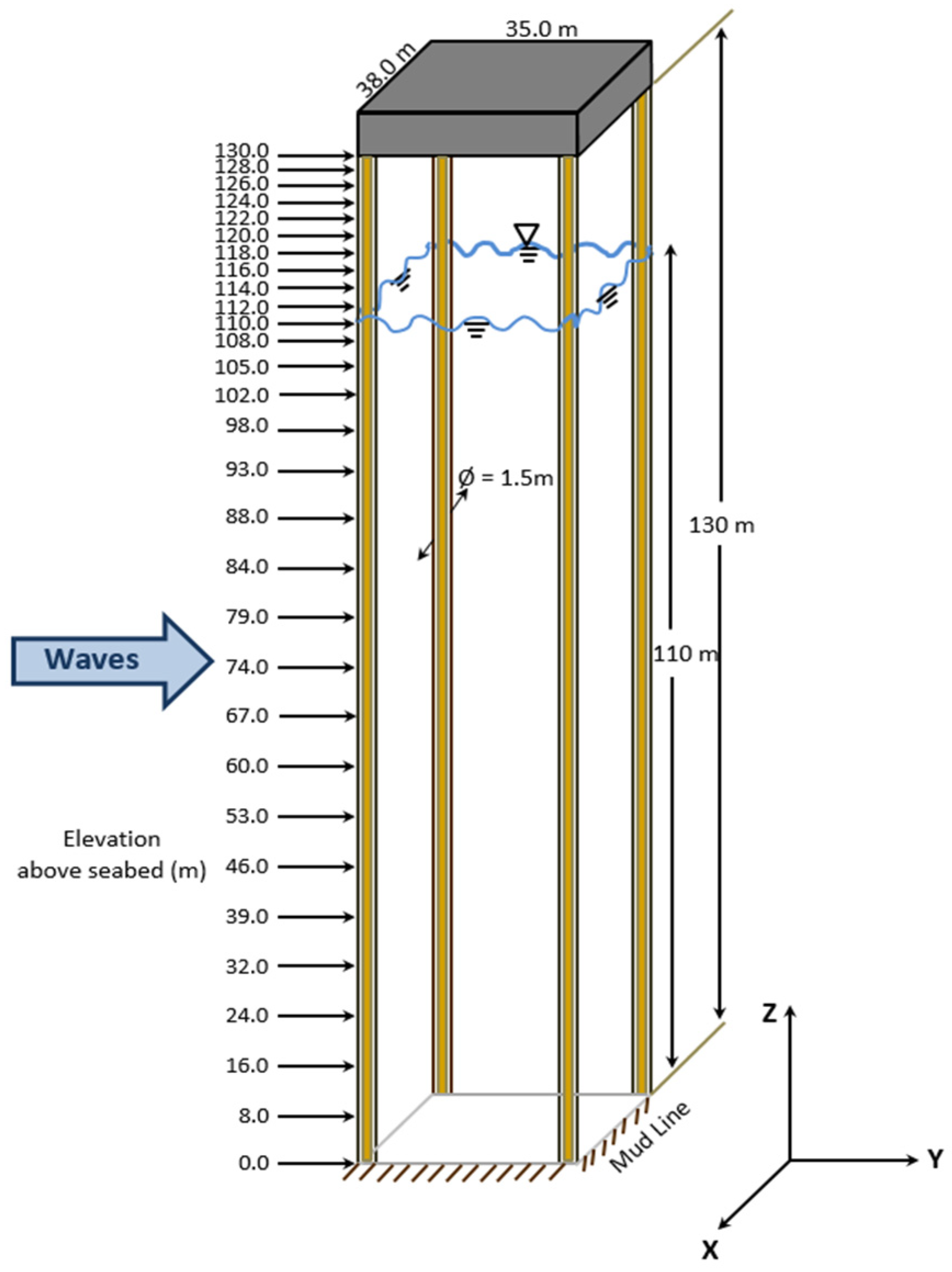
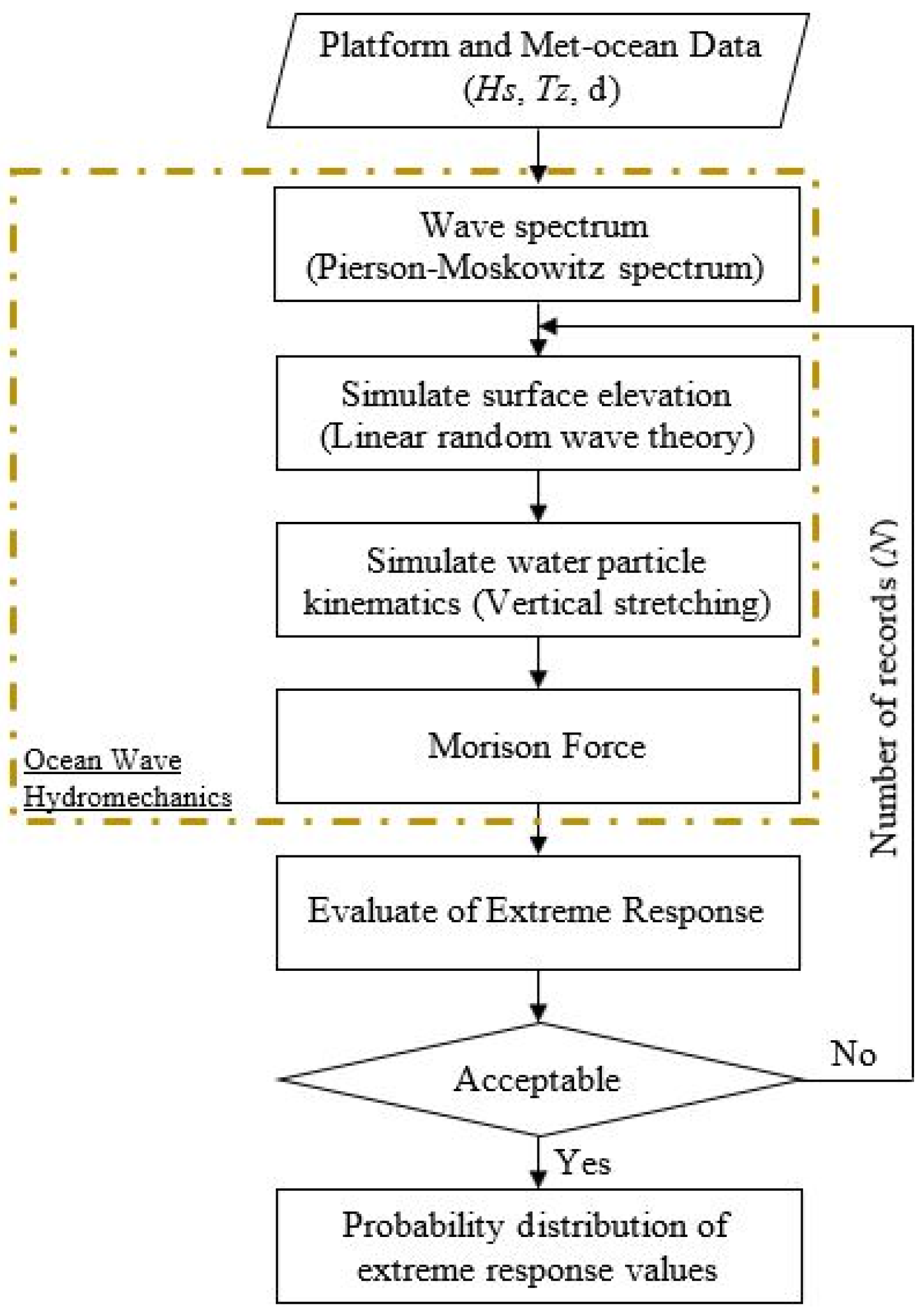

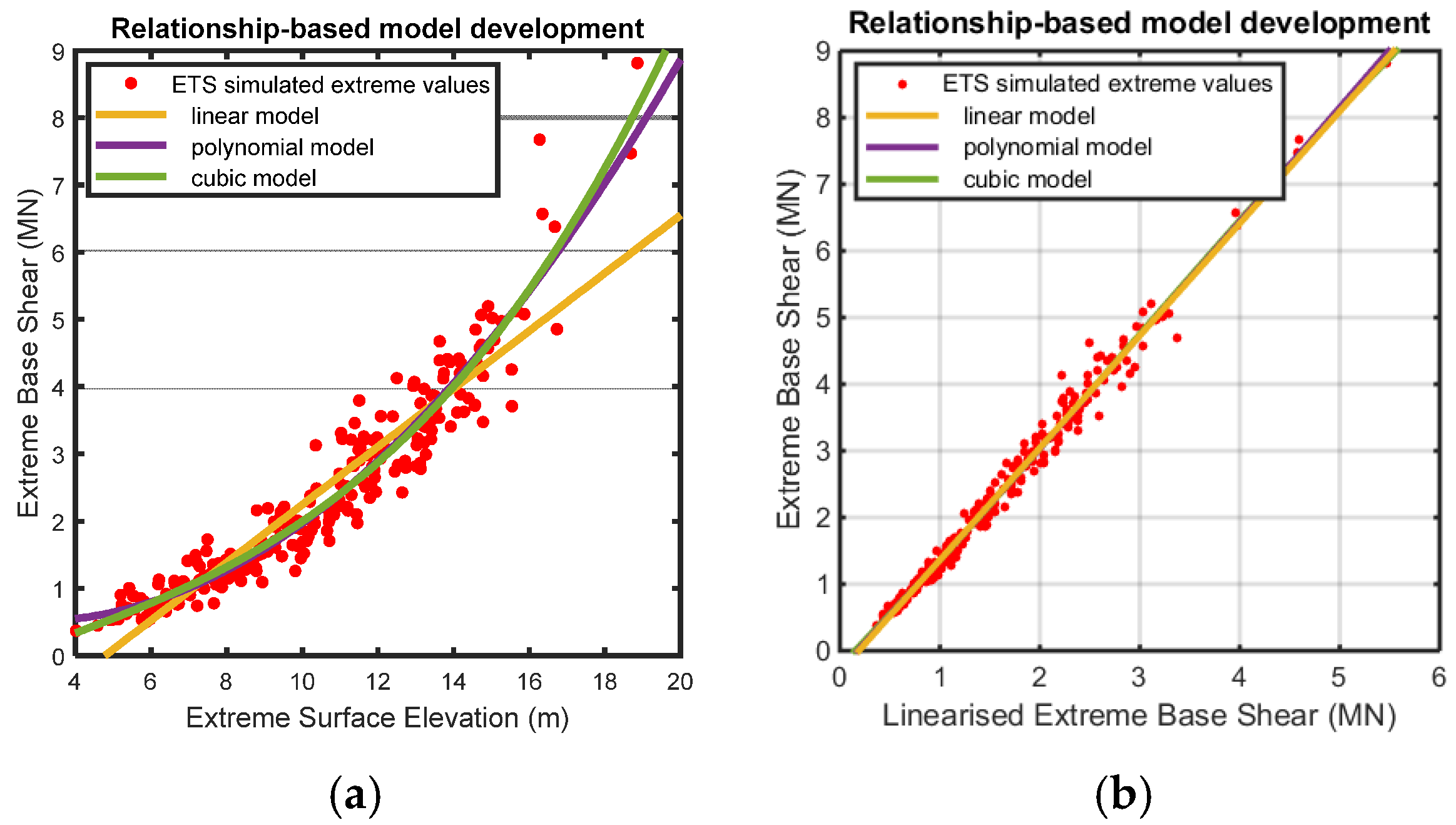
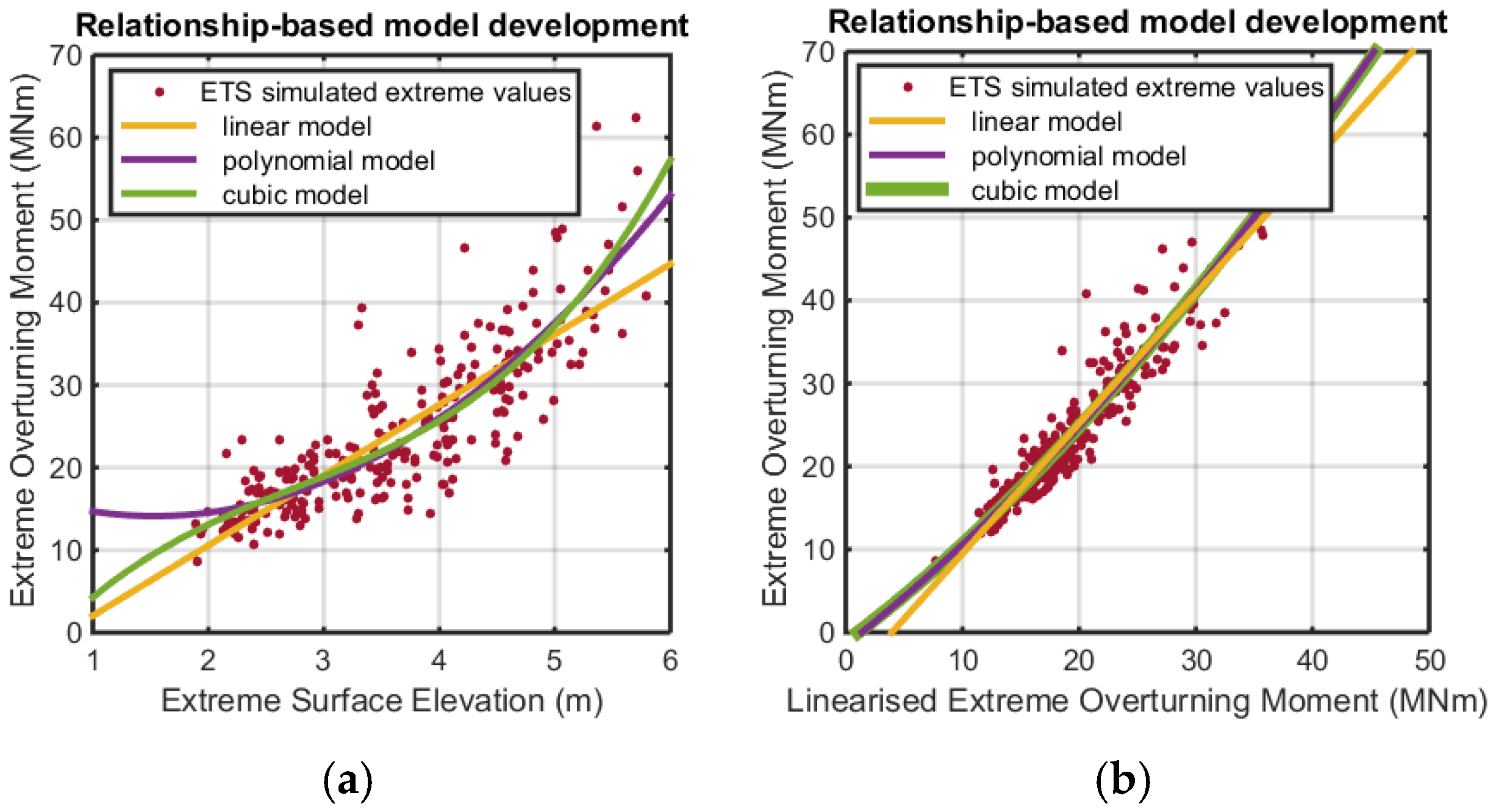

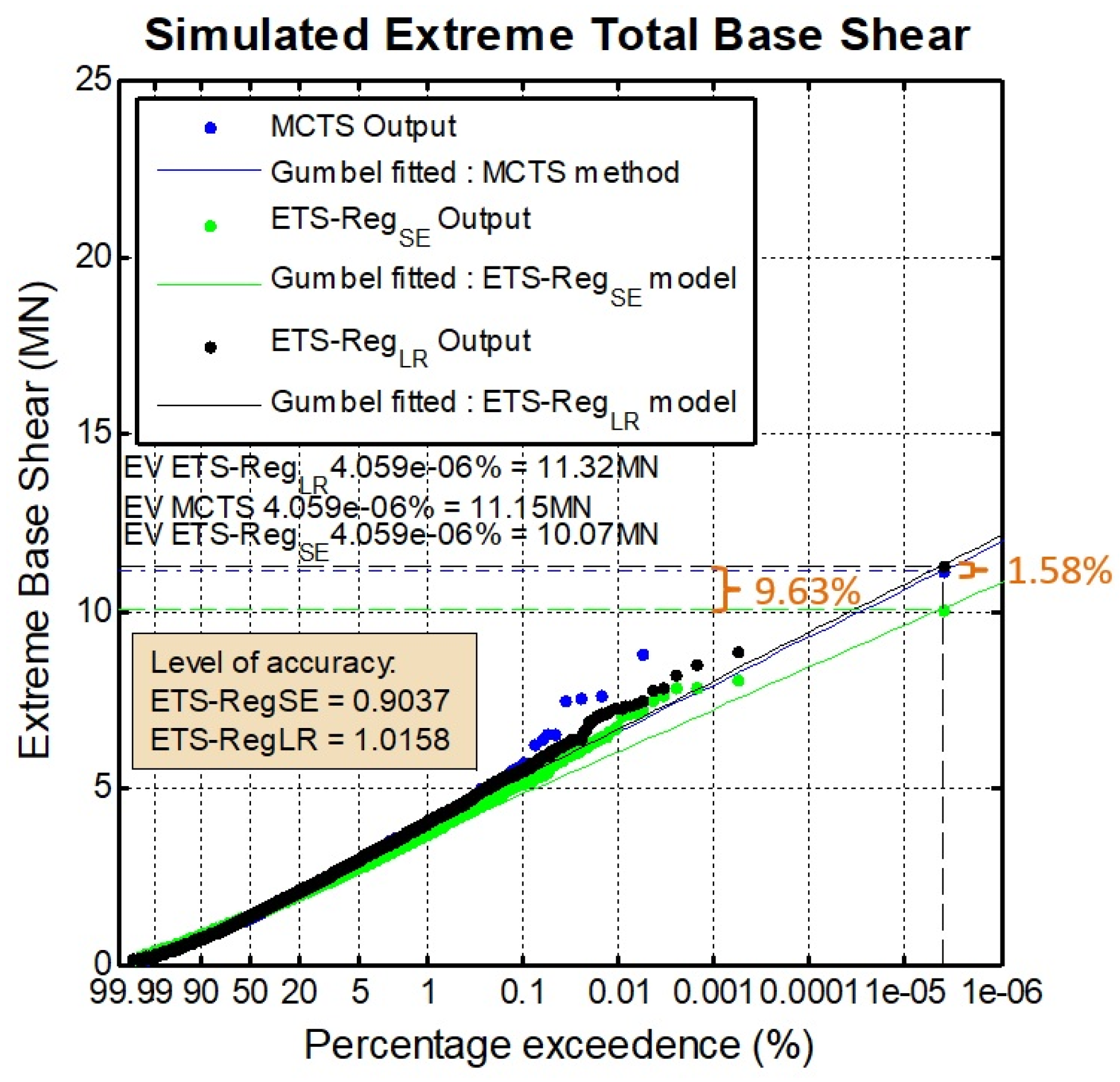
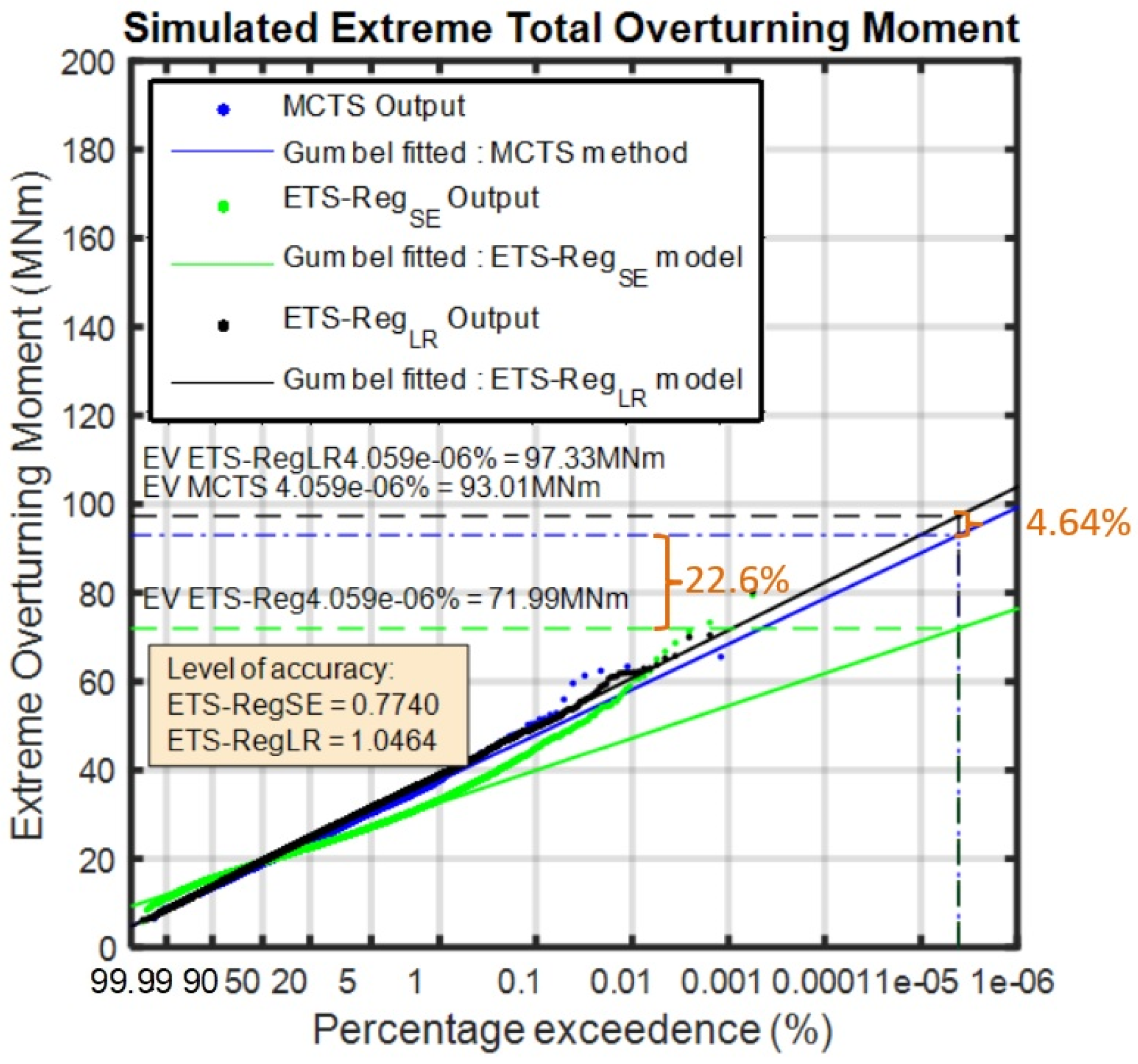
| Base Shear | Overturning Moment | |||
|---|---|---|---|---|
| Type of ETS-Reg (correlation-r) | ETS-RSE | ETS-RLR | ETS-RSE | ETS-RLR |
| r | r | r | r | |
| Significant wave height, Hs = 15 m (high sea state) | ||||
| 0.9408 | 0.9931 | 0.9376 | 0.9922 | |
| Significant wave height, Hs = 5 m (low sea state) | ||||
| 0.8444 | 0.9626 | 0.8360 | 0.9528 | |
| Base Shear | Overturning Moment | |||
|---|---|---|---|---|
| ETS-Reg Models | ETS-RegSE | ETS-RegLR | ETS-RegSE | ETS-RegLR |
| r2 | r2 | r2 | r2 | |
| Significant wave height, Hs = 15 m (high sea state) | ||||
| Linear | 0.8851 | 0.9862 | 0.8792 | 0.9844 |
| Polynomial | 0.9284 | 0.9863 | 0.9304 | 0.9845 |
| Cubic | 0.9296 | 0.9864 | 0.9317 | 0.9846 |
| Significant wave height, Hs = 5 m (low sea state) | ||||
| Linear | 0.7131 | 0.9265 | 0.6988 | 0.9078 |
| Polynomial | 0.7360 | 0.9291 | 0.7345 | 0.9103 |
| Cubic | 0.7377 | 0.9292 | 0.7386 | 0.9105 |
| Method | Prediction | Responses Ratio | ||
|---|---|---|---|---|
| ETS-RegSE | ETS-RegLR | ETS-RegSE MCTS | ETS-RegLR MCTS | |
| Linear | 12.0808 | 11.4266 | 1.0839 | 1.0252 |
| Polynomial | 10.4922 | 11.3804 | 0.9413 | 1.0210 |
| Cubic | 10.0723 | 11.3220 | 0.9037 | 1.0158 |
| Responses | Base Shear | Overturning Moment | ||||
|---|---|---|---|---|---|---|
| Methods | Ratio | Ratio | ||||
| MCTS (MN) | ETS-RegSE MCTS | ETS-RegLR MCTS | MCTS (MNm) | ETS-RegSE MCTS | ETS-RegLR MCTS | |
| Significant wave height, Hs = 15 m (high sea state) | ||||||
| Total responses | 11.1459 | 0.9037 | 1.0158 | 983.7499 | 0.9316 | 1.0087 |
| Significant wave height, Hs = 5 m (low sea state) | ||||||
| Total re-sponses | 0.9795 | 0.8037 | 1.0453 | 93.0112 | 0.7740 | 1.0464 |
Publisher’s Note: MDPI stays neutral with regard to jurisdictional claims in published maps and institutional affiliations. |
© 2022 by the authors. Licensee MDPI, Basel, Switzerland. This article is an open access article distributed under the terms and conditions of the Creative Commons Attribution (CC BY) license (https://creativecommons.org/licenses/by/4.0/).
Share and Cite
Syed Ahmad, S.Z.A.; Abu Husain, M.K.; Mohd Zaki, N.I.; Mukhlas, N.‘A.; Najafian, G. An Improved Version of ETS-Regression Models in Calculating the Fixed Offshore Platform Responses. J. Mar. Sci. Eng. 2022, 10, 1727. https://doi.org/10.3390/jmse10111727
Syed Ahmad SZA, Abu Husain MK, Mohd Zaki NI, Mukhlas N‘A, Najafian G. An Improved Version of ETS-Regression Models in Calculating the Fixed Offshore Platform Responses. Journal of Marine Science and Engineering. 2022; 10(11):1727. https://doi.org/10.3390/jmse10111727
Chicago/Turabian StyleSyed Ahmad, Sayyid Zainal Abidin, Mohd Khairi Abu Husain, Noor Irza Mohd Zaki, Nurul ‘Azizah Mukhlas, and Gholamhossein Najafian. 2022. "An Improved Version of ETS-Regression Models in Calculating the Fixed Offshore Platform Responses" Journal of Marine Science and Engineering 10, no. 11: 1727. https://doi.org/10.3390/jmse10111727
APA StyleSyed Ahmad, S. Z. A., Abu Husain, M. K., Mohd Zaki, N. I., Mukhlas, N. ‘A., & Najafian, G. (2022). An Improved Version of ETS-Regression Models in Calculating the Fixed Offshore Platform Responses. Journal of Marine Science and Engineering, 10(11), 1727. https://doi.org/10.3390/jmse10111727







